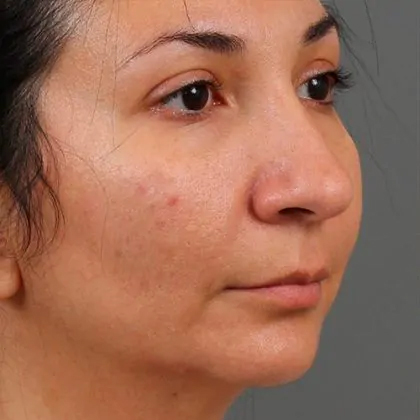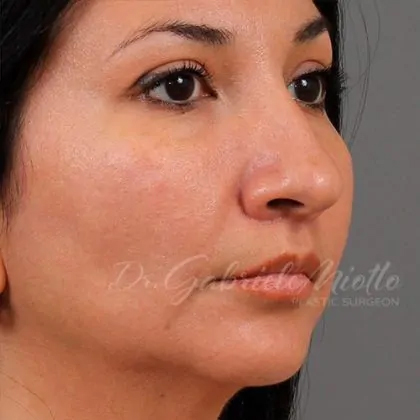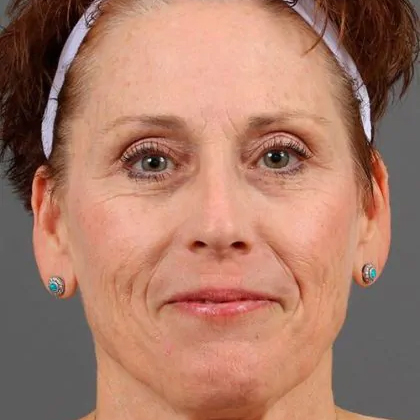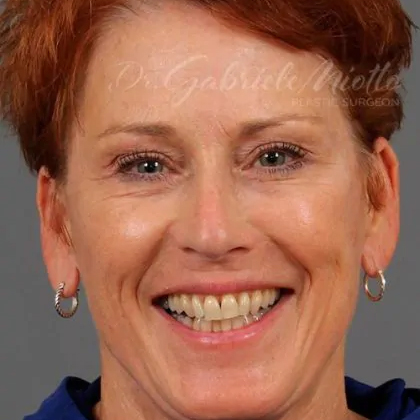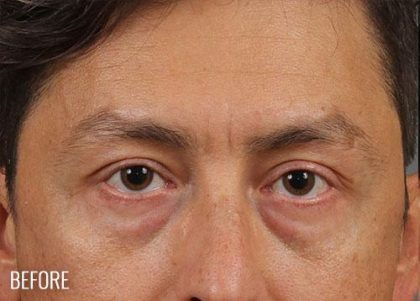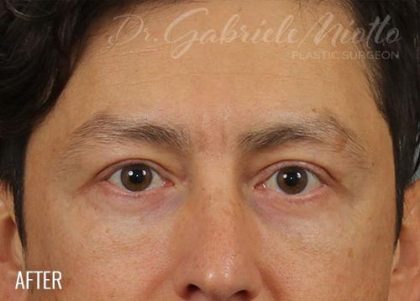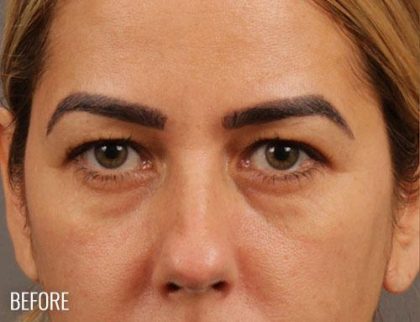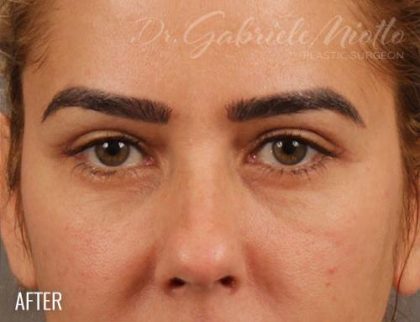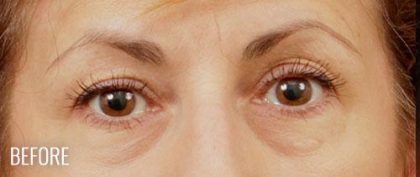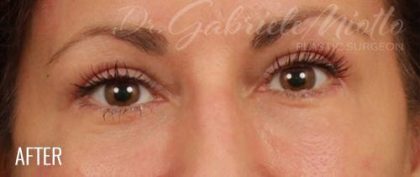Blepharoplasty
Conveniently located to serve the areas of Atlanta, GA
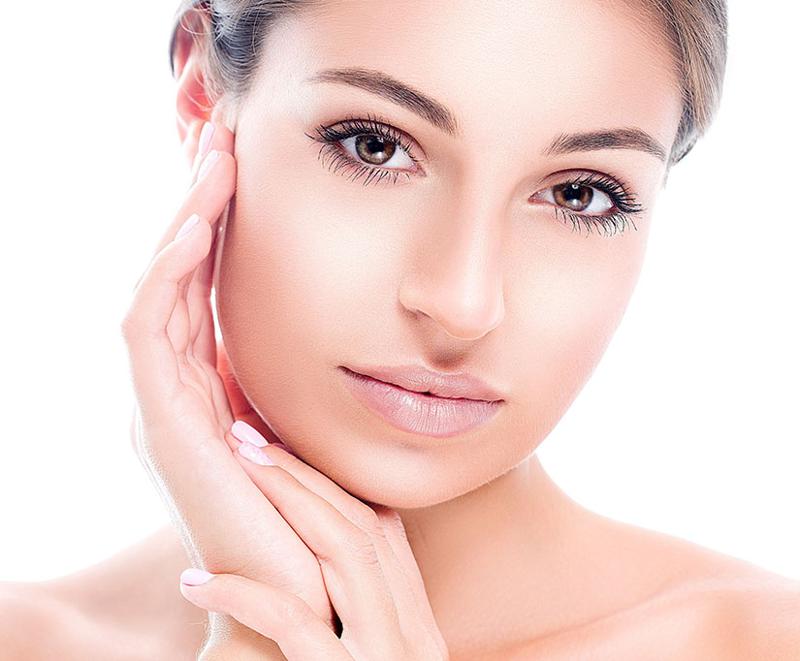
Aesthetic eyelid surgery, known as blepharoplasty or eyelid lift, is a common procedure used to rejuvenate the periocular area and treat excess skin, puffiness, and dark circles to make the appearance of the eyes more vibrant and less tired. During a blepharoplasty, Dr Miotto’s goal is a rejuvenated look. If the eyelids are sunken or hollow, fat grafting can be added to the eyelids for enhanced rejuvenation. Modern eyelid surgery includes removing excessive tissue and adding volume in a very targeted way, mostly by using the patient’s fat.
At ME Plastic Surgery, Dr. Miotto creates beautiful, natural-looking blepharoplasty results for men and women in Atlanta, and also for patients from out of state and from other countries. If you are considering eyelid surgery or any other facial cosmetic procedure, contact ME Plastic Surgery at (404) 850-5851. We also encourage patients to schedule a consultation with Dr. Miotto online. With more than 17 years of experience performing plastic surgery procedures and cosmetic treatments, Dr. Miotto has the skills, knowledge, and vision to help you attain the youthful appearance you desire.
Contents
Before and After Photos
About Blepharoplasty
The eyelids frame and protect the eyes, bringing beauty and expression to the face. The eye region (periocular area) plays a crucial role in our daily interactions. Aging in this area can be very noticeable and starts in our 30s. As we get older, the eyelid skin becomes thinner and it loses elasticity contributing to a “tired” and aged appearance. It is also common to notice more puffiness around the eyes and visible dark circles and wrinkles.
Eyelid surgery, or blepharoplasty, is designed to rejuvenate the eyelids and provide the patient with a more refreshed, youthful-looking appearance. Small incisions are placed inside or outside the eyelids depending on the patient’s goals and anatomy (inside the eyelids – called transconjunctival blepharoplasty. Incision outside the eyelids – under the lash line – a skin pinch blepharoplasty or skin-muscle blepharoplasty). (1) Blepharoplasty is an outpatient surgery performed under local anesthesia and sedation or general anesthesia depending on the case. After the procedure, there will be visible fine skin sutures in the incisions (for skin pinch or skin muscle blepharoplasty) or no sutures (for transconjunctival blepharoplasty).
Benefits
ME Plastic Surgery patients typically experience:
- Treating sagging skin: The skin around your eyelids, brows, and beneath your eyes will be tightened.
- Youthful appearance: Rejuvenates tired-looking eyes, creating a more vibrant and youthful expression.
- Improved vision: Can eliminate upper eyelid excess skin that obstructs peripheral vision, enhancing visual clarity. Eyelid ptosis (droopy eyelid) can also be treated at the same time as a blepharoplasty.
- Reduced puffiness: Removes fat deposits, reducing bulging under the eyes – a common sign of aging.
- Enhanced facial harmony: Balances the appearance of the eyes with the rest of the face, promoting overall symmetry, especially with the addition of fat grafting.
- Quick recovery: With modern techniques, recovery time is relatively short, allowing patients to return to normal activities within a week in most cases.
- Long-lasting results: Provides durable improvements that can help one appear years younger.
Candidates
Most blepharoplasty patients choose to have this procedure when they note visible aging around the eyes, which can start as early as in our 30s. These patients usually have inherited certain eyelid characteristics such as dark circles or undereye bags, that can be addressed with a blepharoplasty. The ideal candidate for a blepharoplasty treatment is in good health, does not smoke, has realistic expectations for their outcome, and is willing to work with their surgeon to create their ideal treatment plan.
Personal Consultation
During the initial consultation, patients should be prepared to discuss their medical history. Dr Miotto needs to know about any medications you are currently taking, treatments, and chronic conditions (e.g., diabetes, hypertension, etc.) as well as information about previous surgical procedures. In addition, please let Dr Miotto and her team know if there are any issues related to previous anesthesia. Allergies to medication and latex should be included in the patient’s information.
Since each patient is unique, every surgical plan that Dr. Miotto creates is designed to meet the needs of a specific patient. When creating a plan, we will consider each patient’s aging patterns, race, facial shape, and goals.
Preparation
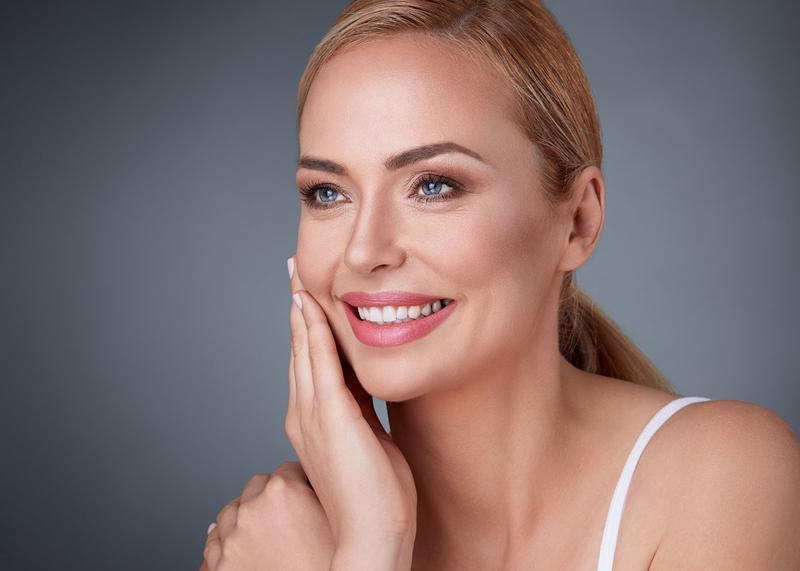
You will receive specific preparation instructions after your consultation. Patients should not take any aspirin or ibuprofen for 7-10 days before their scheduled procedures. Tylenol (acetaminophen) can be taken for any pain. Certain other medications and supplements will also need to be avoided. We recommend avoiding consuming alcohol for at least one week to minimize post-procedure swelling and bruising.
Some vitamins, supplements, and products can help with the healing process. Taking these before surgery as recommended by Dr. Miotto can speed up a patient’s recovery time.
ME Plastic Surgery has a strict policy prohibiting patients from using public transportation or for-hire transportation services when returning home after sedation or general anesthesia. This policy is in place to protect our patients at a time when they may be vulnerable. If your procedure involves any type of sedation, you will be required to arrange transportation and your driver must be with you on the day of your procedure. If not, the treatment will be rescheduled.
Upper & Lower Eyelid Surgery
Patients may receive local anesthesia with oral sedation, IV sedation, or general anesthesia for a blepharoplasty.
Upper Eyelid Surgery
When upper and lower blepharoplasty are performed simultaneously, the procedure takes about two hours, but it can last longer when fat grafting and a brow lift are also part of the global periocular rejuvenation plan.
An incision is created on the upper eyelid. This incision runs along the eyelid crease. Through this incision, the surgeon separates the skin from its underlying tissue and removes the excess fat, skin, and if indicated, and treats the loose muscle. Following this, the underlying tissues are tightened to improve wrinkles. (1) Once the desired changes have been made, the incisions are closed with extremely fine stitches. Stitches remain intact for about a week, and any resulting scars are hidden within the eyelid’s natural crease.
Lower Eyelid Surgery: The Transconjunctival Method
With this method, an incision is created inside the lower eyelid. Dr Miotto uses this incision to access and remove fat that has accumulated in the lower eyelid. Since the transconjunctival incision is created on the inside of the lower lid, it is not visible. This method does not require stitches. Some surgeons call this a “scarless lower eyelid surgery”, but in fact there is a scar hidden inside the eyelid.
Lower Eyelid Surgery: Lash-Line Incision Method
With this technique, an incision is created along the eyelash margin. Using this incision, Dr Miotto treats loose muscle as well as excess fat and skin. The incision is closed using a very fine suture, and although it is created outside under the lash line, it heals relatively quickly and becomes nearly invisible. Once this procedure is complete, the patient has a smoother transition from the lower eyelids to their cheeks.
Canthopexy with Blepharoplasty
A canthopexy is a procedure that tightens the outer corners of the eyelids. It can be performed at the same time as a lower blepharoplasty. (2) A canthopexy procedure is designed to provide additional support to the lower eyelid, preventing it from sagging. Following this procedure, there will be fine sutures visible which will be removed within a week.
Fat Grafting for Lower Eyelids
When a patient has eyelids that look hollow or sunken-in, the patient’s fat can be harvested to use as the patient’s own filler. Once the hollow areas are filled, the patient’s eyes look rejuvenated.
Recovery
- You may have bruising and swelling for a week or 2 after eyelid surgery.
- Some patients may experience dry eyes after their blepharoplasty. This side effect usually only lasts about 2 weeks.
- Patients benefit from keeping their heads elevated using two pillows to sleep at night.
- The fine stitches in the lids are removed within 5 to 7 days.
- Ice packs should be used for the first 48-72 hours after surgery.
- Patients may receive lubricating eye drops to use for a week or two after surgery.
- Full recovery can take from 6 to 12 weeks.
- The final results and healing are achieved at 6 months after surgery.
Please refrain from physical activity that will increase your heart rate or blood pressure for two weeks after surgery. However, bed rest is not recommended, and you should be walking at a normal pace after the procedure. Frequent walking will decrease the risk of postoperative blood clots (mostly after general anesthesia). Our team will provide detailed postop care of your skin and surgical incisions, including scar therapy.
Recovery time will vary; however, most patients return to work within one to two weeks after the procedure.
Results
After eyelid surgery, patients enjoy a more refreshed, youthful-looking, and rejuvenated appearance. The results attained are considered a new “reset”, which will create permanent shape change in the eyelids, and on average it can last up to 7-10 years.
Complementary Procedures
Many patients will incorporate other treatments into their blepharoplasty treatment plan to maximize their rejuvenation. (3) Some of the other treatments frequently performed with blepharoplasty procedures include a browlift, fat grafting, and chemical peels.
Individuals with eyes that appear sunken in can add volume to these areas using their own fat.
There are non-surgical options for a blepharoplasty. For patients with hollowed eyelids, temples, or deep dark circles we can use targeted hyaluronic acid fillers, Renuva, or nanofat to rejuvenate these areas. Aging causes facial deflation or loss of fatty tissue around the eyes which contributes to a tired and aged appearance. Small amounts of Hyaluronic acid fillers are recommended as temporary but effective nonsurgical options and can be repeated as needed. Fat is a more permanent solution but more than one treatment session may be needed depending on how hollow the eyelids and periorbital area appears..
Cost of Eyelid Surgery in Atlanta
Each patient is unique, therefore, the only way to determine how much an individual’s blepharoplasty procedure will cost is with an initial consultation. ME Plastic Surgery also offers financing options for our surgeries procedures. If you have any questions about eyelid rejuvenation procedures, do not hesitate to call our Atlanta office at (404) 850-5851.
FAQ
Is it common to have fat grafting with eyelid surgery?
Yes. Modern eyelid surgery always involves restoring the beauty around the eyes, not just removing fat or skin. When we do eyelid surgery, if we do not replace the areas that have lost fat with new fat, the patient sometimes looks operated on and not rejuvenated. Some fat grafting is necessary to restore the normal youthful anatomy of the eye for most patients.
What is a skin pinch blepharoplasty?
Skin pinch blepharoplasty is the removal of skin only under the eyelash of the lower eyelid. We can also do a skin pinch of the upper eyelid, which removes the skin of the upper eyelid. Skin pinch blepharoplasties create a short downtime. They can be done under local anesthesia, both for the upper eyelid and the lower eyelid in selected cases.
What is a transconjunctival blepharoplasty?
Transconjunctival blepharoplasty, also known as “scarless” blepharoplasty, is a lower eyelid surgery where we make an incision on the inside of the eye and treat the eyelid bags. Fat bags are eliminated permanently with this technique, and patients do not see any scars (it is hidden inside the eyelid)..
Where are the incisions located?
Incision placement will depend on what methods are being used in your blepharoplasty procedure, but they are typically located inside the eyelids, below the eyelids lash line, or in the corners of the eyelids at their natural creases.
References
- Rebowe RE, Runyan C. Blepharoplasty. PubMed. Published 2022. https://www.ncbi.nlm.nih.gov/books/NBK482381/
- Demirci H, Qureshi Z, Bernard A, Grisolia AD, Jaru-Ampornpan P, Ozgonul C. Simplified technique for lateral canthal tendon canthopexy. Indian Journal of Ophthalmology. 2022;70(9):3403. doi:https://doi.org/10.4103/ijo.ijo_3126_21
- Miotto GC, Orr Shauly, Menon A. Lower Eyelid Blepharoplasty With Volume Preservation Using the Skin Flap. Aesthetic Surgery Journal Open Forum. 2023;5. doi:https://doi.org/10.1093/asjof/ojad074


